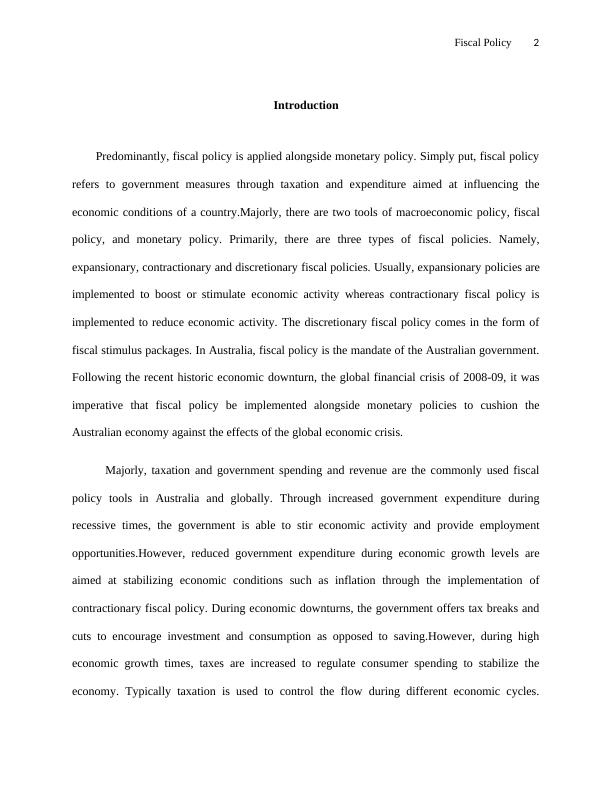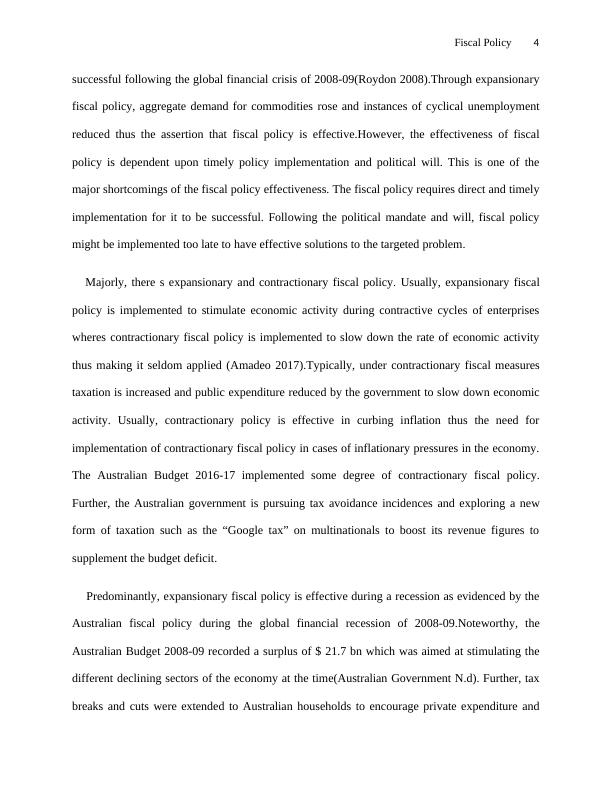Ask a question from expert
Fiscal Policy Economic Assignment
16 Pages3439 Words289 Views
Added on 2020-04-07
Fiscal Policy Economic Assignment
Added on 2020-04-07
BookmarkShareRelated Documents
Fiscal Policy 1ECONOMICS ASSIGNMENTStudents NameCourseProfessors NameUniversity(City)StateDate

Fiscal Policy 2Introduction Predominantly, fiscal policy is applied alongside monetary policy. Simply put, fiscal policyrefers to government measures through taxation and expenditure aimed at influencing theeconomic conditions of a country.Majorly, there are two tools of macroeconomic policy, fiscalpolicy, and monetary policy. Primarily, there are three types of fiscal policies. Namely,expansionary, contractionary and discretionary fiscal policies. Usually, expansionary policies areimplemented to boost or stimulate economic activity whereas contractionary fiscal policy isimplemented to reduce economic activity. The discretionary fiscal policy comes in the form offiscal stimulus packages. In Australia, fiscal policy is the mandate of the Australian government.Following the recent historic economic downturn, the global financial crisis of 2008-09, it wasimperative that fiscal policy be implemented alongside monetary policies to cushion theAustralian economy against the effects of the global economic crisis. Majorly, taxation and government spending and revenue are the commonly used fiscalpolicy tools in Australia and globally. Through increased government expenditure duringrecessive times, the government is able to stir economic activity and provide employmentopportunities.However, reduced government expenditure during economic growth levels areaimed at stabilizing economic conditions such as inflation through the implementation ofcontractionary fiscal policy. During economic downturns, the government offers tax breaks andcuts to encourage investment and consumption as opposed to saving.However, during higheconomic growth times, taxes are increased to regulate consumer spending to stabilize theeconomy. Typically taxation is used to control the flow during different economic cycles.

Fiscal Policy 3Particularly, it can be said that taxation is effective in controlling consumption and productionpatterns due to its direct application through levies and penalties for violations. Noteworthy, Australian fiscal policy played a vital role in reviving the Australian economyafter the negative effects of the recent Global Economic Crisis, also known as the Globalfinancial crisis. However, fiscal policy had the help of monetary policies, demand, and supplybased advantages plus strong regulated financial systems that helped it through the financialcrisis of the year 2008-09.Fiscal Policy Australia. Objectively, fiscal measures are implemented to promote public welfare and economicgrowth through the supply of commodities and to stabilize economic fluctuations. According tothe Australian 2016-17 Budget, small and middle-sized businesses are the beneficiaries of tax cutranging from 28.5 percent to 27.5 percent to encourage growth and expansion. Further, theAustralian Budget 2016-17 has increased the tax bracket of middle-income earners to higherincome earners thus an implementation of fiscal policy through taxation(Focus Economics2016).Noteworthy, in Australia, the fiscal policy is done by the Australian government as amacroeconomic policy. During the global financial crisis, discretionary fiscal policy in the formof fiscal stimulus packages was implemented into the economy(Dolomere n. d).Predominantly,the Australian fiscal policy is based on the Charter of Budget Honesty Act of 1998 whichadvocates for the implementation of medium-term policies. Further, the expansionary fiscal policy was implemented through Australian governmentfinancial handouts and expenditure in medium-term business ventures.For instance, theAustralian government implemented the building schools revolution which is considered

Fiscal Policy 4successful following the global financial crisis of 2008-09(Roydon 2008).Through expansionaryfiscal policy, aggregate demand for commodities rose and instances of cyclical unemploymentreduced thus the assertion that fiscal policy is effective.However, the effectiveness of fiscalpolicy is dependent upon timely policy implementation and political will. This is one of themajor shortcomings of the fiscal policy effectiveness. The fiscal policy requires direct and timelyimplementation for it to be successful. Following the political mandate and will, fiscal policymight be implemented too late to have effective solutions to the targeted problem. Majorly, there s expansionary and contractionary fiscal policy. Usually, expansionary fiscalpolicy is implemented to stimulate economic activity during contractive cycles of enterpriseswheres contractionary fiscal policy is implemented to slow down the rate of economic activitythus making it seldom applied (Amadeo 2017).Typically, under contractionary fiscal measurestaxation is increased and public expenditure reduced by the government to slow down economicactivity. Usually, contractionary policy is effective in curbing inflation thus the need forimplementation of contractionary fiscal policy in cases of inflationary pressures in the economy.The Australian Budget 2016-17 implemented some degree of contractionary fiscal policy.Further, the Australian government is pursuing tax avoidance incidences and exploring a newform of taxation such as the “Google tax” on multinationals to boost its revenue figures tosupplement the budget deficit. Predominantly, expansionary fiscal policy is effective during a recession as evidenced by theAustralian fiscal policy during the global financial recession of 2008-09.Noteworthy, theAustralian Budget 2008-09 recorded a surplus of $ 21.7 bn which was aimed at stimulating thedifferent declining sectors of the economy at the time(Australian Government N.d). Further, taxbreaks and cuts were extended to Australian households to encourage private expenditure and

End of preview
Want to access all the pages? Upload your documents or become a member.
Related Documents
Understanding Fiscal Policy: Tools, Stances, and Objectiveslg...
|4
|667
|264
Managerial Economics: Fiscal Policy, Monetary Policy and Taxationlg...
|7
|851
|307
Scope for Using Fiscal Policy to Stabilize the Economy with High Public Debtlg...
|9
|2402
|454
Economics for Managers BUS702lg...
|5
|891
|135
Fiscal Policy and its Implementation in Singapore in 2020lg...
|5
|1045
|71
Effects of fiscal policy on the Australian construction industrylg...
|6
|1057
|23